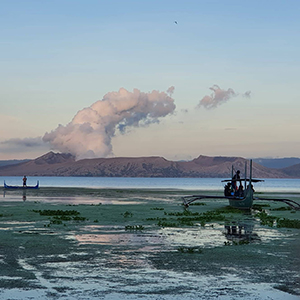Identification of aquatic consumer trophic pathways in four volcanic tropical lakes using fatty acid biomarkers

All claims expressed in this article are solely those of the authors and do not necessarily represent those of their affiliated organizations, or those of the publisher, the editors and the reviewers. Any product that may be evaluated in this article or claim that may be made by its manufacturer is not guaranteed or endorsed by the publisher.
Authors
Food web studies rely heavily on the use of traditional gut content analysis or the fairly popular stable isotope analysis rather than fatty acid analysis (FAA) despite its straightforward process, and ability to identify and characterize more diverse trophic pathways. In this study, we employed fatty acid (FA) biomarkers as a preliminary attempt to trace and characterize trophic pathways in food webs of four tropical lakes of volcanic origin in Luzon Island, Philippines - three clustered maar lakes (Yambo, Pandin and Calibato) and a large caldera lake (Taal). These lakes have a long history of human disturbance but limited ecological data. Knowledge of basal food sources and existing trophic dynamics of organisms are generally non-existent. Particulate organic matter (POM), zooplankton, and fish species were collected in August 2019 from the study lakes as representative of three trophic guilds. Non-metric multidimensional scaling (NMDS) and principal component analysis (PCA) were conducted to analyse FA profiles and characterize trophic relationships between representative organisms. For the POM, within lakes comparison of taxon-specific FA profiles showed a significant difference between the surface and near bottom depths, with the former dominated by photoautorophs and the latter by chemotrophs, suggesting the ability of FAA to effectively delineate between micro-organisms. Between lakes comparison also showed significant difference between the caldera and maar lakes, with the latter containing higher composition of bacterial FA, reminiscent of the considerably smaller lakes’ response to the impact of unmitigated organic loadings from anthropogenic activities. Taken together with the primary consumers’ FA profiles, analysis confirmed the ability of FAA to discriminate between FA profile sources. PCA explained >70% of the variance in the FA compositions for three trophic guilds in the two deepest lakes, which delineated both zooplankton and fish species food selectivity in each lake, alluding to FAA’s capacity to characterize dietary reliance of various species in an environment with numerous food sources. Although certain limitations were encountered, such as the specificity of the sampling depths for POM, and the small sample size of the representative species of the third trophic level, this study demonstrated the effectiveness of FAA as a powerful ecological tool for disentangling intricate lake food webs comprising various food sources. Overall, this study provided baseline information on basal food sources and trophic pathways of representative organisms from four tropical lakes. Taken together, FAA studies have wide application in understanding food webs, including anthropogenically-threatened lake ecosystems.
Edited by
Diego Copetti, CNR-IRSA Brugherio, ItalyHow to Cite

This work is licensed under a Creative Commons Attribution-NonCommercial 4.0 International License.






